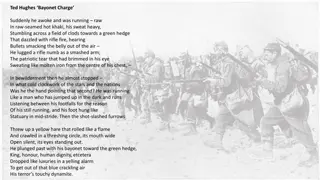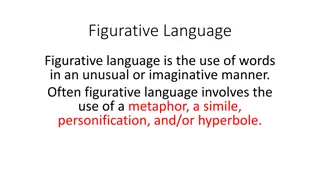Enhancing Literary Appreciation Through Stylistics and Ornamentation
Explore the world of literary texts with Md. Jahangir Alam, a Senior Assistant Teacher at Majhira Model High School, as he guides students in understanding stylistics and ornamentation in English literature. Through experimental learning cycles and activities like analyzing similes, metaphors, and e
1 views • 17 slides
Enhancing Descriptive Writing with Similes and Metaphors
Using similes and metaphors can greatly enhance descriptive writing by creating vivid imagery and engaging comparisons. This interactive content explores the definition of similes and metaphors, provides examples, and encourages practice through exercises related to the sun, rain, wind, and more. It
0 views • 6 slides
Understanding Figurative Language Through Examples
Explore various examples of figurative language such as personification, idioms, similes, metaphors, hyperboles, onomatopoeia, and alliteration. Analyze each example and categorize them correctly in the provided grid to enhance your understanding of figurative language.
0 views • 7 slides
Creative Writing Adventure: Story Planning and Similes
Delve into the world of creative writing with activities such as crafting similes, planning stories, and using descriptive language to bring adventures with snails and whales to life. From comparing objects to weaving captivating tales, this engaging journey sparks imagination and writing skills.
0 views • 6 slides
Mastering Character Descriptions: Show, Don't Tell Techniques
Enhance your character descriptions by utilizing language devices such as similes, metaphors, alliteration, verbs, adjectives, and adverbs. Learn how to show rather than tell by using vivid descriptions and unique synonyms. Understand how readers infer character traits through details like name, age
0 views • 11 slides
Understanding Figurative Language: Similes and Metaphors
Figurative language, like similes and metaphors, adds depth and creativity to writing. Similes use "like" or "as" to make comparisons, while metaphors directly state one thing is another. Through examples and imagery, the power of these literary devices is showcased, helping readers visualize and in
1 views • 6 slides
Analysis of Figurative Language in "Sinners in the Hands of an Angry God
This analysis delves into the prominent use of similes and metaphors in Jonathan Edwards' famous sermon, "Sinners in the Hands of an Angry God." The comparisons made in the text vividly depict God's wrath and control over humanity, invoking powerful imagery to convey the severity of sin and the cons
0 views • 7 slides
Stranded on a Desert Island: A Tale of Survival and Adventure
Embark on a thrilling journey as you follow a character who finds themselves shipwrecked on a deserted island. Through engaging storytelling and vivid imagery, explore the character's emotions, struggles, and triumphs as they navigate the challenges of the unknown. Dive into the depths of character
0 views • 15 slides
Exploring Figurative Language: Simile, Metaphor, Personification, Hyperbole
Figurative language enhances descriptions by comparing elements to create vivid imagery. This presentation explores simile, metaphor, personification, and hyperbole, providing examples and explanations for each. Similes use "like" or "as" to draw comparisons, while metaphors state facts metaphorical
0 views • 6 slides
Enhancing Writing Skills Through Varied Sentence Structures
Enhance your writing skills by incorporating diverse sentence structures like relative clauses, onomatopoeia, interesting openers, personification, similes, connectives, adverbs, and fronted adverbials. Practice through quick starts, onomatopoeia exploration, and slow writes to improve control and p
0 views • 6 slides
Exploring Figurative Language in Literature
Figurative language adds depth and imagery to writing by using words or expressions in a non-literal way. Common examples include simile, metaphor, personification, onomatopoeia, hyperbole, and symbolism. Similes compare two unlike things using "like" or "as," while metaphors directly equate them. P
0 views • 8 slides
Understanding Figurative Language in Literature
Figurative language adds depth and creativity to writing by using words in ways beyond their literal meanings. Examples include metaphors, similes, alliteration, and hyperbole. Poetry often employs figurative language to evoke sensory experiences and emotions. Allusions and idioms are also common fo
0 views • 32 slides
Analysis of Ted Hughes' Poem "Bayonet Charge
The poem "Bayonet Charge" by Ted Hughes delves into the chaotic and harrowing experience of a soldier in the midst of battle. The vivid imagery, use of similes and rhetorical questions highlight the confusion, fear, and sense of insignificance felt by the soldier as he navigates the brutal realities
0 views • 11 slides
Understanding Figurative Language in Frankenstein
Figurative language in Frankenstein plays a crucial role in conveying deeper meanings and creating vivid imagery. Similes and metaphors are used to draw comparisons between characters and objects, adding layers of complexity to the narrative. Through examples like comparing Elizabeth's soul to a shr
2 views • 15 slides
Exploring Figurative Language: Metaphors, Similes, Hyperboles, and Personification
Figurative language enhances communication by using imaginative expressions like metaphors, similes, hyperboles, and personification. Metaphors compare two things directly, similes use "like" or "as," hyperboles exaggerate, and personification attributes human traits to non-human entities.
0 views • 5 slides
Understanding Figurative Language: A Guide to Metaphors, Similes, and More
Figurative language is a powerful tool used by writers to evoke emotions and create vivid imagery in the minds of readers. It goes beyond literal meanings, allowing for deeper interpretations and connections with the subject matter. This guide explains the difference between figurative and literal l
0 views • 40 slides
Exploring Figurative Language in Writing
Figurative language enhances writing by creating visual imagery and deeper meaning. Understanding its use improves reading comprehension, plot analysis, and character motivation recognition. Through examples like similes, metaphors, personification, and idioms, readers can grasp the nuances of figur
0 views • 9 slides
Exploring Literary Devices and Techniques in Storytelling
Delve into the world of storytelling with an examination of key literary devices and techniques such as plot, exposition, rising action, climax, falling action, and denouement. Understand the significance of similes, metaphors, personification, and other tools that bring narratives to life.
0 views • 82 slides
Exploring Social Class in "The Doll's House" by Katherine Mansfield
The short story "The Doll's House" by Katherine Mansfield delves into themes of social class, prejudice, connection, hope, appearance, and equality. Through vivid storytelling, Mansfield sheds light on the inhumanity of class discrimination and the longing for genuine equality. With rich metaphors,
0 views • 10 slides
Comprehensive Guide to Imaginative Writing: Unit 1 - Mood, Sentence Structures, and Techniques
This comprehensive guide explores various aspects of imaginative writing, including defining mood in literary texts, understanding sentence structures, and learning techniques such as adjectives, similes, metaphors, and more. The unit covers big questions, tasks, and lessons to help students enhance
1 views • 35 slides
Crafting Compelling Stories: Tips and Techniques for Writers
Explore tips on creating captivating settings, developing realistic characters, starting a story effectively, using descriptive writing techniques, and enhancing your stories with literary devices like alliteration, rhyme, and similes. Enhance your storytelling skills with practical advice and examp
0 views • 10 slides
Exploring Alliteration and Similes Through Famous Examples
Delve into the world of alliteration and similes with examples from a famous 90-year-old's work and everyday usage. Learn how to identify and create these figurative language devices, and discover their impact on literature and daily communication.
0 views • 11 slides
Examples of Figures of Speech in Poetry
This collection showcases various examples of figures of speech used in poetry by renowned poets such as Andrew Marvell, Coleridge, Wordsworth, R.S. Thomas, and John Donne. The excerpts include metaphors, similes, personification, and other literary devices, offering a diverse range of creative expr
1 views • 10 slides
Mastering Noun Phrases for Vivid Descriptions
Explore the art of crafting compelling noun phrases to vividly describe dragons and other fantastical creatures. Learn techniques such as using determiners, hyphenated adjectives, prepositional phrases, similes, and relative pronouns to create imaginative and detailed descriptions. Elevate your writ
0 views • 15 slides
Exploring Metaphors and Similes in Language
Discover the essence of metaphors and similes through engaging examples and creative exercises. Learn to distinguish between the two literary devices and unleash your imagination as you delve into the world of figurative language.
0 views • 5 slides
Explore the World of Similes: Enhancing Your Comparisons
Delve into the realm of similes, a creative way to compare two things using "like" or "as". Learn about the two common patterns of similes and practice creating your own comparisons using various adjectives. Unleash your imagination with engaging examples and enhance your descriptive language skills
0 views • 20 slides
Understanding Figurative Language Through Quotations
Explore the concept of figurative language by analyzing quotations that demonstrate similes, metaphors, and personification. Discover how writers use comparisons to enhance meaning and develop a deeper understanding of literary texts.
0 views • 43 slides
Language Arts Class Agenda for January 12, 2016
Independent reading and in-class assignment on similes and poetry with a focus on denotation and connotation. Learning targets include writing similes, deciphering a poem's message, and understanding the difference between denotation and connotation. Success criteria involve completing pages 4 and 5
0 views • 13 slides
Exploring the Language of Poetry - Figurative Expressions Unveiled
Delve into the enchanting realm of poetry where figurative language reigns supreme. Discover the beauty of similes, metaphors, extended metaphors, hyperboles, personifications, and more, as they weave intricate tapestries of imagery and emotion in poetic compositions. Unravel the depth and power of
0 views • 24 slides
Themes of Contrast and Curiosity in "Dr. Jekyll and Mr. Hyde
The chapters of "Dr. Jekyll and Mr. Hyde" explore themes of aggression, violence, good versus evil, and curiosity through vivid language and character interactions. Contrasting adverbs, negative phrasing, and repetitions are used to highlight the duality of human nature. The characters Enfield, Utte
0 views • 54 slides
Understanding Figures of Speech in Writing
Learn about imagery and figures of speech in writing, including similes, metaphors, and personification. Immerse yourself in the use of words to create vivid images that appeal to the senses. Explore examples and gain insights into how these tools can enhance your writing.
0 views • 16 slides
Themes and Transformations in "A Christmas Carol" by Dickens
Dickens uses vivid similes and metaphors to depict Scrooge's cold-heartedness and isolation, highlighting his need for change. Marley's fate serves as a warning to Scrooge, emphasizing the importance of redemption. Belle's departure symbolizes Scrooge's loss of love due to greed. The Ghost of Christ
0 views • 10 slides
Enhancing Descriptive Writing Skills Through Engaging Tasks
Explore a variety of writing tasks designed to enhance descriptive writing skills, including using nouns, adjectives, verbs, and adverbs creatively. Learn about descriptive techniques such as metaphors, similes, and imagery to enrich your writing. Practice choosing precise vocabulary to create diffe
0 views • 8 slides
Exploring Homeric Similes: Epic Comparisons and Analysis
Delve into the world of epic similes and epithets with a focus on Homer's works. Discover the beauty of these literary devices through vivid comparisons like a sponge absorbing water and a musician strumming a harp. Unravel the hidden meanings behind passages comparing suitors to caught fish and Ody
0 views • 12 slides
Exploring Similes: Figures of Speech with Creative Examples
Delve into the world of similes, where one thing is compared to another using "like" or "as". Uncover the power of similes through engaging examples such as "as brave as a lion" and "like tangled spaghetti". Discover how similes evoke vivid imagery and enhance writing. Engage in tasks to analyze, ch
0 views • 23 slides
Comparative and Superlative Forms in English - Adjectives and Similes
Explore the world of adjectives and similes through this engaging content showcasing the different forms of comparison in English language. From simple adjectives to complex similes, learn how to convey degrees of comparison effectively. Enhance your vocabulary and grasp the nuances of expressing co
0 views • 9 slides
Lost Words Teaching Resources - Creative Exploration of Food Tastes Through Similes
Engage in a creative exploration of food tastes through the use of similes with Lost Words Teaching Resources. Share your favorite similes with the group and receive constructive feedback in a supportive environment led by Andrew Graves, writer, Hannah Sawtell, artist, and Natalie Braber, project di
0 views • 6 slides
Exploring Metaphors, Similes, Symbols, and Evocative Settings in Writing
Discover the nuances of metaphors, similes, symbols, and evocative settings in literature. Dive into the power of metaphor and how it enriches storytelling. Explore the importance of using these literary devices effectively to create captivating narratives. Uncover the significance of settings in sh
0 views • 7 slides
Understanding Similes in English Language: Examples and Explanation
Learn about similes and how they are used in the English language through examples and explanations provided by Md. Robiul Islam, an Assistant Teacher of English at Pioneer Girls High School in Khulna. Discover the definition of similes, common words used in similes (like, as, than), and see various
0 views • 9 slides
Understanding Figurative Language: Similes, Metaphors, and Imagery
Explore the world of figurative language through similes, metaphors, and imagery. Discover how similes compare qualities using "like" or "as" with examples like "You are as pretty as a rose." Learn about metaphors that make comparisons without using "like" or "as" such as "The car was a whale." Dive
0 views • 20 slides







































